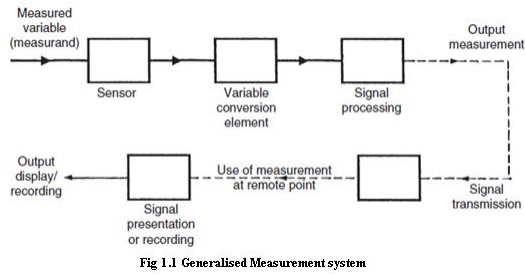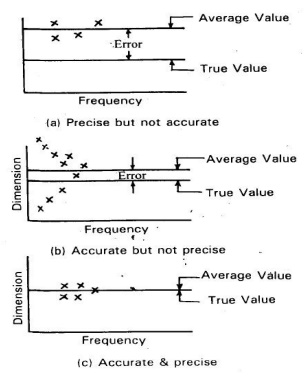Chapter: Mechanical : Metrology and Measurements : Concepts of Measurement
Generalized Measurement System
GENERALIZED MEASUREMENT SYSTEM
A
measuring system exists to provide information about the physical value of some
variable being measured. In simple cases, the system can consist of only a
single unit that gives an output reading or signal according to the magnitude
of the unknown variable applied to it.
However, in more complex measurement situations, a measuring system
consists of several separate elements as shown in Figure1.1.

Units
Table
1.1 Physical Quantities and its unit

Standards
The term standard is used to denote
universally accepted specifications for devices. Components or processes which
ensure conformity and interchangeability throughout a particular industry. A
standard provides a reference for assigning a numerical value to a measured
quantity. Each basic measurable quantity has associated with it an ultimate
standard. Working standards, those used in conjunction with the various
measurement making instruments.
The national institute of standards and
technology (NIST) formerly called National Bureau of Standards (NBS), it was
established by an act of congress in 1901, and the need for such body had been
noted by the founders of the constitution. In order to maintain accuracy,
standards in a vast industrial complex must be traceable to a single source,
which may be national standards.
The following is the generalization of
echelons of standards in the national measurement system.
1. Calibration
standards
2. Metrology
standards
3. National
standards
1. Calibration
standards: Working standards of industrial or
governmental laboratories.
2. Metrology
standards: Reference standards of industrial or
Governmental laboratories.
National standards: It
includes prototype and natural phenomenon of SI (Systems International),
the world wide system of weight and measures standards. Application of precise
measurement has increased so much, that a single national laboratory to perform
directly all the calibrations and standardization required by a large country
with high technical development. It has led to the establishment of a
considerable number of standardizing laboratories in industry and in various
other areas. A standard provides a reference or datum for assigning a numerical
value to a measured quantity.
Classification
of Standards
To maintain accuracy and
interchangeability it is necessary that Standards to be traceable to a single
source, usually the National Standards of the country, which are further linked
to International Standards. The accuracy of National Standards is transferred
to working standards through a chain of intermediate standards in a manner
given below.
•National Standards
•National Reference Standards •WorkingStandards
•Plant Laboratory Reference
Standards
•Plant Laboratory Working
Standards
•Shop Floor
Standards
Evidently, there is degradation of
accuracy in passing from the defining standards to the shop floor standards.
The accuracy of particular standard depends on a combination of the number of
times it has been compared with a standard in a higher echelon, the frequency
of such comparisons, the care with which it was done, and the stability of the
particular standards itself.
Accuracy of
Measurements
The purpose of measurement is to
determine the true dimensions of a part. But no measurement can be made
absolutely accurate. There is always some error. The amount of error depends
upon the following factors:
•
The
accuracy
andinstrumentdesign of the
measur
•
The
skill of the
operator
•
Method
adopted for measurement
•
Temperature variations
•
Elastic
deformation of the
part or in
Thus, the true dimension of the part
cannot be determined but can only by approximate. The agreement of the measured
value with the true value of the measured quantity is called accuracy. If the
measurement of dimensions of a part approximates very closely to the true value
of that dimension, it is said to be accurate. Thus the term accuracy denotes
the closeness of the measured value with the true value. The difference between
the measured value and the true value is the error of measurement. The lesser
the error, more is the accuracy.
Precision
The terms precision and accuracy are
used in connection with the performance of the instrument. Precision is the
repeatability of the measuring process. It refers to the group of measurements
for the same characteristics taken under identical conditions. It indicates to
what extent the identically performed measurements agree with each other. If
the instrument is not precise it will give different (widely varying) results
for the same dimension when measured again and again. The set of observations
will scatter about the
mean. The scatter of these measurements is
designated as σ, the sta used as an index of precision. The less the scattering
more precise is the instrument.
Thus, lower, the
value of σ,
the more prec
Accuracy
Accuracy is the degree to which the
measured value of the quality characteristic agrees with the true value. The
difference between the true value and the measured value is known as error of
measurement. It is practically difficult to measure exactly the true value and
therefore a set of observations is made whose mean value is taken as the true
value of the quality measured.
Distinction between Precision and
Accuracy

Accuracy is very often confused with precision
though much different. The distinction between the precision and accuracy will
become clear by the following example. Several measurements are made on a
component by different types of instruments (A, B and C respectively) and the
results are plotted. In any set of measurements, the individual measurements
are scattered about the mean, and the precision signifies how well the various
measurements performed by same instrument on the same quality characteristic
agree with each other. The difference between the mean of set of readings on
the same quality characteristic and the true value is called as error. Less the
error more accurate is the instrument. Figure shows that the instrument A is
precise since the results of number of measurements are close to the average
value. However, there is a large difference (error) between the true value and
the average value hence it is not accurate. The readings taken by the
instruments are scattered much from the average value and hence it is not
precise but accurate as there is a small difference between the average value
and true value.
Factors affecting the
accuracy of the Measuring System
The basic components of an accuracy
evaluation are the five elements of a measuring system such as:
•
Factors
affecting the calibration
sta
•
Factors
affecting the work
piece.
•
Factorsngthe
inherentaffecticharacteristics of the instrument.
•
Factors
affecting the person,
who car
•
Factors
affecting the environment.
1. Factors
affecting the Standard: It may be affected by:
-Coefficient
of thermal expansion
-Calibration
interval
-Stability
with time
-Elastic
properties
-Geometric
compatibility
2.
Factors affecting the Work piece:
These are: -Cleanliness
-Surface finish, waviness, scratch, surface defects
etc., -Hidden geometry
-Elastic properties,-adequate datum on the work
piece -Arrangement of supporting work piece
-Thermal equalization etc.
3.
Factors affecting the inherent
characteristics of Instrument: -Adequate
amplification for accuracy objective
-Scale error
-Effect of friction, backlash, hysteresis, zero
drift error
-Deformation in handling or use, when heavy work
pieces are measured -Calibration errors
-Mechanical parts (slides, guide ways or moving
elements) -Repeatability and readability
-Contact geometry for both work piece and standard.
4. Factors
affecting person:
-Training,
skill
-Sense
of precision appreciation
-Ability to select measuring instruments and
standards -Sensible appreciation of measuring cost
-Attitude
towards personal accuracy achievements
-Planning measurement techniques for minimum cost,
consistent with precision requirements etc.
5. Factors affecting Environment:
-Temperature,
humidity etc.
-Clean surrounding and minimum vibration enhance
precision -Adequate illumination
-Temperature equalization between standard, work
piece, andinstrument -Thermal expansion effects due to heat radiation from
lights
-Heating
elements, sunlight and people
-Manual
handling may also introduce thermal expansion.
Higher
accuracy can be achieved only if, ail the sources of error due to the above
five elements in the measuring system are analyzed and steps taken to eliminate
them. The above analysis of five basic metrology elements can be composed into
the acronym SWIPE, for convenient reference where,
S –STANDARD W
–WORKPIECE I –INSTRUMENT
P
–PERSON E –ENVIRONMENT
Related Topics